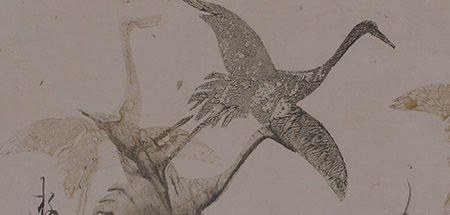Sōtatsu: Making Waves
October 24, 2015‒January 31, 2016
Arthur M. Sackler Gallery
(日本語)
Tawaraya Sōtatsu (ca. 1570‒ca. 1640), a fountainhead of Japanese painting and design, is one of the most influential yet elusive figures in Japanese culture. Sōtatsu’s work is instantly recognized by its bold, abstracted style, lavish swaths of gold and silver, and rich jewel tones. Much of the artist’s life, however, remains a mystery. How a working-class owner of a Kyoto fan shop transformed into a sophisticated designer with a network of aristocratic collaborators is still an enigma.
Sōtatsu: Making Waves is the first in-depth examination of this major Japanese artist. The exhibition convenes for the first time more than seventy of Sōtatsu’s masterpieces from collections in Japan, Europe, and the United States, along with homage pieces by later artists that demonstrate his long-ranging influence. Highlights include Waves at Matsushima and Dragons and Clouds, along with fans, albums, hanging scrolls, and paintings. The Freer|Sackler is the only venue for this first major Sōtatsu retrospective in the Western Hemisphere.
Museum founder Charles Lang Freer, a prescient late nineteenth-century collector who amassed several of Sōtatsu’s most noted paintings, is widely credited with introducing both Sōtatsu and his frequent collaborator Hon’ami Kōetsu (1558–1637) to Western audiences. Due to restrictions in Freer’s will, the works cannot travel outside the Freer and Sackler Galleries, making this exhibition a watershed moment in our understanding of Sōtatsu.
Sōtatsu: Making Waves is co-organized by the Freer Gallery of Art and Arthur M. Sackler Gallery and the Japan Foundation.

The exhibition is supported by All Nippon Airways Co., Ltd.
Special thanks to Tokyo University of the Arts.
A full-color exhibition catalogue will be published in fall 2015. Contributors include Nakamachi Keiko of the Jissen Women’s University; Okudaira Shunroku of Osaka University; Furuta Ryo of University Art Museum, Tokyo University of the Arts; Yukio Lippit of Harvard University; James Ulak of the Freer|Sackler; Noguchi Takeshi of Nezu Art Museum; and Ota Aya of the Imperial Household Collections.
The Importance of Sōtatsu
In early seventeenth-century Kyoto, Sōtatsu, a talented craftsman, found himself at the center of a momentous shift in Japanese society. When the ancient royal court ceded its power to rising classes of warriors and merchants, a new audience emerged, eager to bedeck itself with the trappings of the cultural elite. Sōtatsu, through his experimental painting techniques and brilliantly conceived compositions, transformed and translated Japan’s tightly controlled courtly artistic style for this new age.
His revolutionary designs, and the works created by later followers, coalesced into the style known as rinpa, a triumph of Japanese aesthetics that emerged in the early seventeenth century and continued into the early twentieth century. Despite being named for the Edo-period painter Ogata Kōrin (1658–1716), rinpa (translated as “school of Rin”) owes much of its legacy to Sōtatsu and Kōetsu. In fact, it was Sōtatsu who advanced the vitally important painting technique known as tarashikomi (“dropping in”), in which paint is dropped into a still-wet background to create delicate, serendipitous details such as flower petals and water ripples.
Sōtatsu’s influence cannot be overstated. By the late nineteenth century, rinpa was firmly established as a major movement and, to some extent, became synonymous in the West with Japanese culture. The first modern Sōtatsu exhibition in Tokyo in 1913 galvanized the art world, inspiring a new generation of Japanese artists. His designs echo within the works of luminaries such as Klimt and Matisse—and throughout Art Deco style—making his four hundred-year-old paintings appear unexpectedly contemporary.
Japan’s cultural leaders have declared 2015 as the 400th anniversary of the beginning of the rinpa style, commemorating the shogun’s gift of land in 1615 that formed Kōetsu’s Kyoto artist colony. This exhibition, made possible through a partnership among international scholars and lenders, will complement rinpa displays throughout Japanese museums.
Explore
Galleries »
Flowers and Grasses of the Four Seasons
Right Screen »
Left Screen »
Timeline »
Rotation Schedule »






